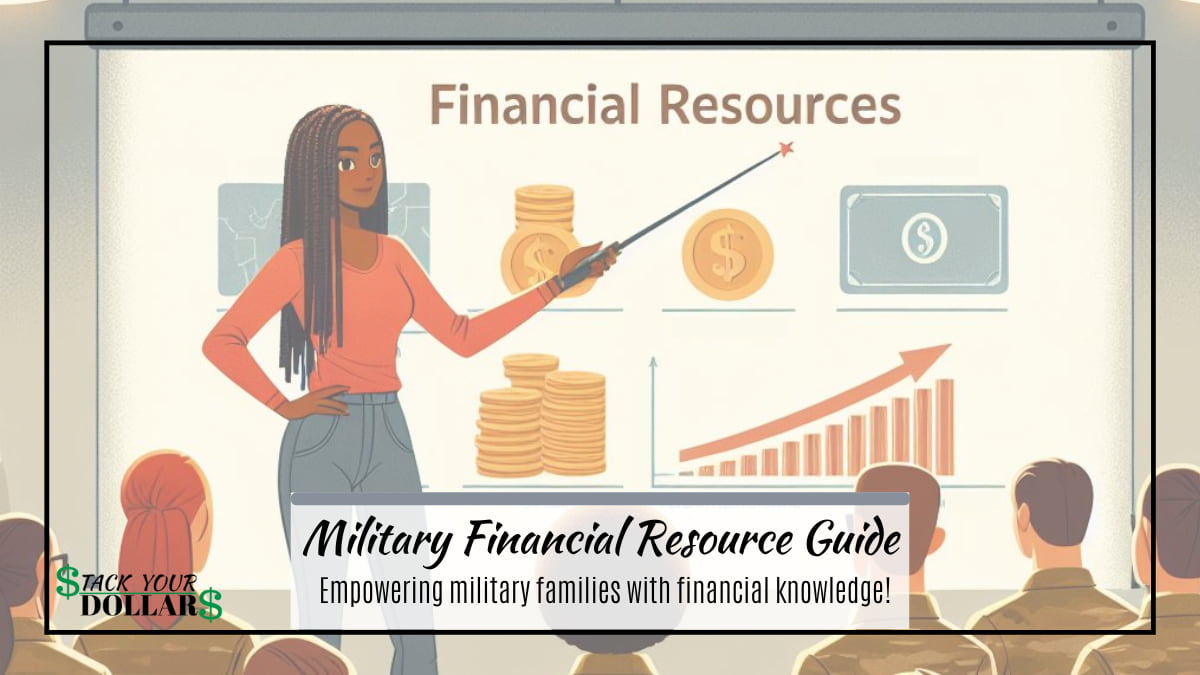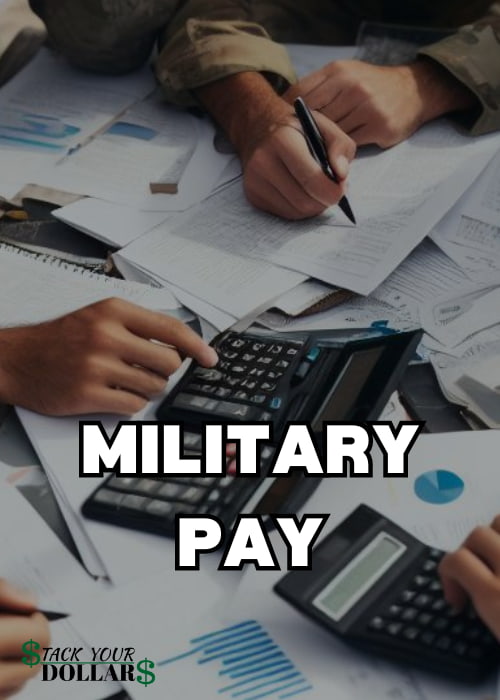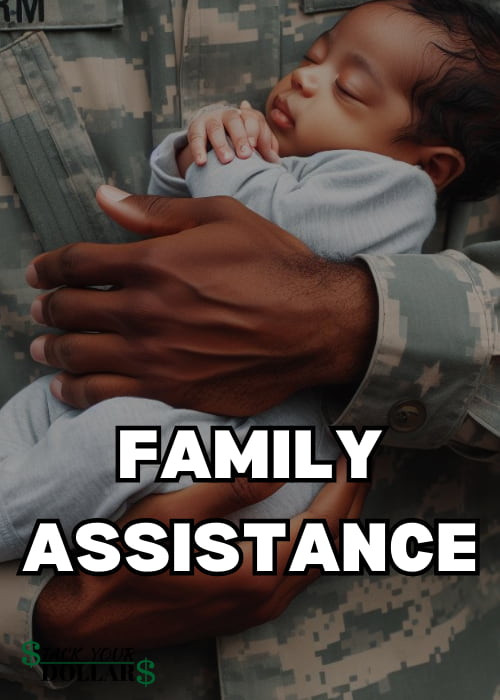I understand how difficult it can be to manage your finances while serving in the military. Therefore, I have put together a Military Financial Resource Guide that will assist you in navigating the financial landscape with ease. Whether you are a seasoned veteran or a new recruit, this guide is filled with valuable information that will ensure your financial well-being.
Furthermore, I will provide helpful links for each topic, enabling you to approach your military career with financial confidence. Let us delve into the specifics.

Military Pay
The landscape of a military member’s paycheck comprises various types of pay and allowances. It’s essential to understand these components and know where to find their amounts, as they play a pivotal role in managing your budget effectively. Click the link of each term to find where you can calculate your entitlement.

The main components of a military member’s compensation typically include:
- Basic Pay: A fixed amount paid based on rank (or pay grade) and years of service. It forms the core of your earnings, with additional allowances and special pay that may be added. Understanding your Basic Pay is crucial for effective budget management and planning for financial success in your military career.
- BAH (Basic Allowance for Housing): This significant perk of military life is a fixed housing allowance based on the zip code of your duty station, the current year, pay grade, and dependency status. BAH is designed to help cover the cost of housing, ensuring military members and their families have suitable living arrangements while on active duty.
- OHA (Overseas Housing Allowance): For those stationed overseas, the Overseas Housing Allowance (OHA) provides compensation for housing-related expenses. Similar to BAH, OHA considers factors like location, pay grade, and dependents. Unlike BAH, OHA is meant to reimburse actual housing costs and any extra cannot be kept.
- BAS (Basic Allowance for Subsistence): An allowance provided to cover the cost of meals, BAS ensures that military members have financial support for their daily sustenance. However, it’s important to note that if a military member is attached to a command that provides meals, the BAS pay is automatically adjusted to reflect this provision, preventing double compensation for meals. The current compensation is $460.25/ month for enlisted members and $316.98/ month for officers.
Additional Types Of Pay
Alongside those usual entitlements, you may also receive:
- Overseas COLA (Cost-of-Living Allowance): In addition to housing, military members stationed abroad may receive a Cost-of-Living Allowance (COLA). This allowance is to offset the price of being in an area that has a higher cost of living than average in the U.S. A few places in the U.S. also have CONUS COLA. However, COLA amounts fluctuate by pay period and should not be used to base your budget.
- Special and Incentive Pay: Special and Incentive (S&I) pay has specific purposes: enhancing recruiting and retention in critical specialties, compensating for demanding or hazardous assignments, and incentivizing skill development aligned with national security objectives. It’s crucial to be aware of these opportunities, especially when you find yourself in situations that surpass the typical call of duty.
- Clothing Allowance: The Clothing Allowance is a yearly stipend designed to ease the financial burden of maintaining your military wardrobe. Uniform pieces can be pricey, and this allowance helps offset those costs. My suggestion? Consider saving this annual allowance to alleviate the impact on your budget. Additionally, explore military thrift shops for fantastic deals, ensuring you dress sharp without breaking the bank.
- Family Separation Allowance (FSA): This allowance is entitled to involuntarily separated families that are unable to relocate together to a new duty station for reasons such as medical, housing availability, or others. It is also received when the military member is away on orders for more than 30 continuous days. The current amount of compensation is $250/ month.
PCS and Travel Allowances
When you receive your Permanent Change of Station (PCS) orders, it can be both thrilling and overwhelming. From travel allowances to per diem rates, it’s essential to grasp all the details to plan your move more effectively. To guarantee you get the full allowances you’re entitled to, keep accurate records of your expenses.

Let’s tackle the financial aspects of moving with some helpful tips.
- Dislocation Allowance (DLA): DLA serves to offset miscellaneous moving costs not covered by reimbursement. These may include restocking your food pantry and acquiring cleaning supplies that can’t be transported. DLA calculations are based on the service member’s pay grade and dependency status.
- Temporary Lodging Allowance (TLA): Authorized for service members and/or their dependents arriving at or departing from an overseas duty station (OCONUS), TLA assists in covering temporary lodging expenses while awaiting permanent housing or before PCSing.
- Temporary Lodging Expense (TLE): Similar to TLA, TLE aids service members and their families in covering temporary lodging costs, but it applies to moves within the Continental United States (CONUS). It can be used in the gaining or losing Permanent Duty Station (PDS) area.
- Per Diem: Per diem is a predetermined daily allowance provided to cover expenses incurred with official government travel. It includes expenses for meals, lodging, and incidental costs and increases per dependent. Per diem starts on the day of departure from the PDS and ends upon return or when checking into a new PDS.
- M&IE: Along with lodging, M&IE (Meals and Incidental Expenses) is an allowance. that covers the costs of meals (breakfast, lunch, and dinner) and incidental expenses, such as tips for services. The M&IE rate is often set by government regulations and can vary depending on the location of travel.
- Mileage Rates: If you use your own vehicle for a PCS or TDY (Temporary Duty), you can get money back for the expenses of using your vehicle. There are different rates like TDY rate, PCS/MALT (monetary allowance in lieu of transportation) rate, and other rates for situations where you drove your own vehicle even though a government vehicle was an option.
- Personally Procured Move (PPM): Formerly known as a DITY move, opting for a PPM can be a financial win for your family. By assuming control of your move, you can pocket the money the military would have spent on hiring a moving company. Depending on your rank and the weight of your household goods, the compensation you receive to offset the expenses may surpass the actual costs of executing the move, allowing you to keep the surplus. It’s important to note, though, that the compensation you receive is subject to taxation.
Housing
One of the significant aspects of financial planning for military families involves housing. Whether exploring military housing options, considering the benefits of BAH for housing allowances, or looking into the advantages of a VA loan for homeownership, understanding the choices available is vital for creating a stable and secure home base for military families.

- Military Housing: Military housing offers service members and their families a convenient and supportive living environment. It’s worth exploring if you prioritize proximity to base services and the camaraderie of fellow military families. Keep in mind that availability may vary, and waiting lists could impact your timing. Most military housing also takes the whole BAH.
- BAH for Renting: Using Basic Allowance for Housing (BAH) to rent off-base is a popular option. Renting provides the freedom to select a residence that suits your family’s needs. It can provide a lot of savings if chosen wisely. These sites can assist in helping to find a rental:
- VA Home Loan: The VA loan is a powerful home financing option for eligible veterans and service members. Administered by the Department of Veterans Affairs, VA loans offer compelling benefits, including no down payment, lower interest rates, no Private Mortgage Insurance (PMI), and flexible credit requirements.
Ultimately, the decision between military housing, using BAH for renting, or utilizing a VA loan for buying depends on your unique circumstances and preferences. Take the time to weigh the pros and cons, consider your family’s needs, and make an informed choice that aligns with your financial well-being. Explore further insights in my related post, “Rent, Buy, or Military Housing?”
Tax Help
Military life comes with unique tax considerations, and it’s crucial to make the most of available resources. Let’s explore some tax help options tailored to the military community.

- Military OneSource MilTax: Did you know that Military OneSource offers free tax services? Yep, you heard that right! They provide e-filing software and personalized support. So, why pay for tax assistance when you can get it for free?
- State Taxes: While you might be stationed far from home, don’t forget about your state tax obligations. Each state has different rules regarding military income, and staying informed can save you from potential tax headaches. Thanks to the Servicemembers Civil Relief Act (SCRA), military members only have to pay taxes to the state they’re a resident of and not where they’re stationed.
- Military Spouses Residency Relief Act (MSRRA): An extension of the SCRA, the MSRRA provides spouses of military members with similar residency protections. This allows military spouses to pay income tax solely based on their resident state, provided it aligns with the military member’s residency.
Financial Assistance
Navigating the military financial world also involves knowing your options for financial assistance. In times of need, loans can provide crucial support.

Here are some avenues to explore:
- Emergency Relief Organizations: Several military-specific emergency relief organizations offer interest-free loans or grants to service members facing unexpected financial challenges. Organizations like the Navy-Marine Corps Relief Society, Army Emergency Relief, and Air Force Aid Society are dedicated to providing financial assistance during times of need.
- Navy-Marine Corps Relief Society: Offers quick assist loans to active duty Sailors and Marines, providing support of up to $1,000.
- Army Emergency Relief: Eligible Soldiers can receive loans ranging from $250 to $500 to address pressing financial needs.
- Air Force Aid Society: Supporting Air Force and Space Force families, AFAS offers two types of loans for assistance. The Falcon Assistance provides a quick loan of up to $1,500, while a Standard Assistance Loan/Grant is available for more significant emergency situations.
- Coast Guard Mutual Assistance: The CGMA stands ready to assist U.S. Coast Guard families with quick loans of up to $1,500, providing timely support during challenging circumstances.
Education Assistance
We’ve all heard a bit about the GI Bill, but there’s more to explore when it comes to education assistance for military members and their families. Whether you’re pursuing a degree during service or planning for post-military education, understanding the available programs can open doors to a brighter future.

- GI Bill: Enacted in 1944 to provide educational and vocational benefits to veterans returning from World War II, the GI Bill has since undergone several revisions and expansions. It offers financial assistance for education, including college degrees, vocational training, and various other educational programs, aiming to help veterans reintegrate into civilian life and build successful careers.
- Department of Defense (DoD) Tuition Assistance (TA): TA offers financial support to Service members engaging in voluntary off-duty education programs, providing up to $4,000 per year to assist in pursuing professional and personal self-development goals.
- DANTES-sponsored CLEP testing: CLEP testing enables individuals to earn credits for courses they already possess sufficient knowledge in, allowing them to bypass unnecessary coursework and associated expenses. DANTES covers the cost for the first attempt of these tests.
- NMCRS Education Assistance Program: This resource provides scholarships up to $3,000 and interest-free loans up to $4,000.
- Army Emergency Relief Scholarships: Spouses may apply for the Mrs. Patty Shinseki Spouse Scholarship Program for their undergraduate degree or a technical certification. There is also a Maj. Gen. James Ursano Scholarship Program for Dependent Children and a Pentagon Victims Scholarship Program.
- AFAS education grants, scholarships, and loans: There are several different scholarships and loans offered for educational support to the spouses and children of Airmen and Guardians.
- MyCAA: My Career Advancement Account Scholarship is a program that provides eligible spouses with up to $4,000.
- NMFA Military Spouse Scholarships: These scholarships from the National MilitaFamily Association offer $500 – $2500 for a variety of educational expenses such as a GED, degree, re-licensure, continuing education courses, and more.
- Scholarships for Military Children Program: This program by the Fisher House Foundation offers a scholarship grant of $2000 to unmarried military dependent children under the age of 23.
- Heroes’ Legacy Scholarship: This Fisher House Foundation scholarship is funded by the year’s proceeds from Barack Obama’s book, “Of Thee I Sing: A Letter to My Daughters.” It is offered to certain families of active duty military members who have died or become disabled since September 11, 2001.
Family Assistance
Ensuring military families have affordable access to child care is a big deal. In this section, we will explore resources that go beyond the basics, offering financial assistance, home nurse visits, childcare support, and enlightening budgeting workshops. These invaluable resources are designed to foster financial well-being for families within the military community.

- Budget for Baby: This budgeting workshop by the Navy-Marine Corps Relief Society provides families with the knowledge of how to prepare for the financial impact that having a baby has. When expecting families attend the workshop they also receive a $50 gift card and a hand-crafted blanket.
- MilitaryChildCare.com: This DOD website is where military families seeking child care can find more information and request care. Available military child care programs include the Child Development Centers (CDC), Family Child Care (FCC), 24/7 Center, and School Age Care (SAC).
- MCCYN Child Care Fee Assistance Program: The Military Child Care in Your Neighborhood (MCCYN) is a DoD and U.S. Coast Guard-funded program created to support families who are unable to access their service-based childcare services. It assists in the cost difference of acquiring community-based child care.
- AER Childcare Assistance Program: Designed for Army families during Permanent Change of Station (PCS) moves in high-cost areas, this program offers eligible families up to $500 per month to cover fees exceeding the Army Fee Assistance.
Financial And Legal Protections
Military families, like any other, may encounter unique challenges and circumstances that make financial and legal protections particularly important for them. Frequent relocations, deployment-related financial strain, and the need for specific legal safeguards during active duty necessitate measures to ensure stability, access to benefits, and protection against exploitation.

Here are some measures enacted to safeguard military families’ well-being:
- The Servicemembers Civil Relief Act (SCRA): As we journey through financial support for military families, it’s essential to highlight the Servicemembers Civil Relief Act (SCRA). The SCRA offers a range of financial and legal protections, from capping interest rates on pre-existing loans to postponing foreclosure proceedings. This act is a crucial piece of legislation that goes above and beyond to protect the financial interests of active-duty service members.
- Interest Rate Caps: SCRA limits interest rates on loans taken out before entering active duty to 6%. I’ve witnessed some families receive thousands back when applying for this SCRA benefit with their credit card company.
- Foreclosure Protection: The act offers protection against foreclosure, ensuring that military families can maintain their homes without the added worry of losing their residence during periods of active service.
- Lease Termination Rights: SCRA allows service members to terminate residential leases without penalty under certain conditions, offering flexibility during relocations and deployments.
- Court Proceedings Postponement: The act allows for the postponement of certain court proceedings, providing service members the necessary time to focus on their military duties without the added pressure of legal matters.
- Preventing Fraud & Identity Theft: When you’re a military member busy protecting our country and constantly on the move, it’s harder to keep a careful eye on your credit. To minimize the risk of someone committing fraud in your name or having your identity stolen, you can set up an active duty alert for free with one of the three credit card bureaus. Once you do this with either Equifax, TransUnion, or Experian, they will spread it to the others.
Maximizing Your Savings
Making the most of available resources is crucial. There are many ways for military families to save some hard-earned cash.

- Commissary: Also known as the military grocery store, the commissary is a fantastic resource for tax-free savings on your grocery bills.
- Military Exchange: The military exchange, whether it’s the Army and Air Force Exchange Service (AAFES), Navy Exchange (NEX), or Marine Corps Exchange (MCX), provides more than just groceries. Enjoy tax-free shopping, and discount retail brands, and take advantage of promotions, loyalty programs, and special military discounts for substantial savings on various items.
- Military Ticket Offices: Ticket offices on military bases offer discounted tickets for amusement parks, special events, and recreational activities. Additionally, they provide support with travel arrangements.
For more ways to maximize savings, take a look at my post on more discounted and free things for military families.
Conclusion
In conclusion, this comprehensive Military Financial Resource Guide aims to equip you with the tools and knowledge to navigate the intricate landscape of military finances. Covering aspects from understanding your pay to maximizing tax benefits and leveraging PCS allowances, these insights are tailored to empower you on your financial journey.
Recognizing that financial well-being is integral to a successful military career, the key takeaway is that armed with the right knowledge, you can confidently march forward. Stay financially informed and thank you for your service!
